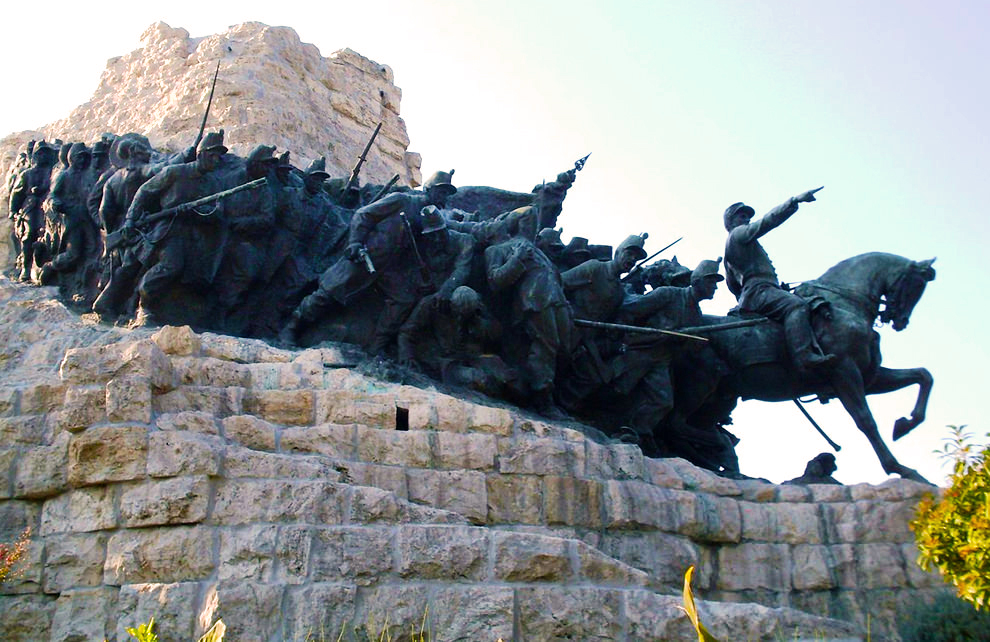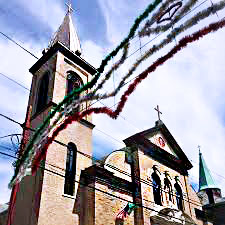Located in the region of Le Marche, the province of Macerata stretches from the shores of the Adriatic Sea inland to a landscape punctuated by hills and valleys. The namesake of the province is situated on a hill 1,030 feet above sea level and can trace its foundation back to the year 1138. It was during the next two centuries that it expanded its territory by annexing numerous of nearby castles. In 1290, the town formed its university, one of the oldest in the world. Long a possession of the Papal States, in 1320, Macerata received the title of Civitas (City) and became the seat of its Papal governor.
In the 15th century, the town was ruled by the powerful Sforza family, but it later returned to the Papacy. It was also during that century that Macerata was severely struck by frequent outbreaks of plague, which decimated the population. During one of the terrible epidemics, the inhabitants erected a chapel dedicated to the Madonna of Mercy; later it was rebuilt following the plans of Vanvitelli and was christened the Basilica della Madonna della Misericordia. It is famous for its richly decorated marble interior and works of art, as well as for its intimate size. It is the smallest basilica in the world.
The Renaissance period also shined its light upon the area and a great building fervor consumed the people who were not struck down by the plague. A new Cathedral was built in Macerata, as well as the refurbishing of the Piazza del Duomo. Construction began on the town Clock Tower and also the Saint Francis Cloister.
The 16th century is considered the golden period, which witnessed the official recognition of the university, which still has its departments and offices within the medieval center of town. Many of the historical features of Macerata are associated with this period, such as the construction of the walls of the city. It was also during that century that the main plaza of the town, Piazza della Libertà was completed. It is surrounded by the Loggia dei Mercanti, built in 1504 and the Palazzo del Governo, where the Pope’s representative ruled for more than three centuries.
Teatro Lauro Rossi is the town’s opera house and it opened in 1774, with a setting of the libretto L’Olimpiade by Pasquale Anfossi. It was renamed in honor of local composer Lauro Rossi in 1884. The musical season is soon coming into bloom, with Musicultura, a national music competition taking place in June. The opera season begins in July. Teatro Lauro Rossi is one of the venues, as is Sferisterio di Macerata, an open air theater dating from 1829. Constructed in Neoclassical style, with a line of arches separated by 56 columns and carrying a double row of boxes, it is 60 feet high and 288 feet long.
As the importance of Rome as a center of power expanded, Macerata entered a period of regression. The local nobility, excluded from power, still left their mark in the form of sumptuous villas and mansions. Palazzo Buonaccorsi is an excellent example. The 18th century aristocratic palace now serves as the civic museum and is located in the historic center of the city. The museum includes a Pinacoteca, with a gallery spanning works from the medieval period to modern times and a broad spectrum of Italian artists. The beautifully decorated rooms from the 18th century provide a setting for the artwork that few museums can match. The museum’s library, Biblioteca Amedeo Ricci, houses a priceless collection of rare books. The Palazzo is also the location for the Museo della Carrozza, containing 22 carriages that were donated by aristocratic families of the region and restored to working condition. In the northeast portion of the province, located outside the town of Potenza Picena, is the family’s villa, which contains one of Italy’s least known, but most fascinating gardens.
Along the Adriatic Sea is the beach town of Civitanova Marche, just south of Porto Potenza Picena. The town has the lively spirit of a vacation destination, plus the historical significance of the ancient city of Alta. Originally a fishing village, it maintains its oldest part in the historic center of Civitanova Alta in the hills, while the area of Porto Civitanova is for the vacationers.
To the north is the seaside town of Porto Recanati. With miles of beaches and turquoise waters, this quaint town also began as a fishing village. Colorful houses over two hundred years old dot the coastline and fishermen still ply their trade, as they have for many generations. A walk along the Corso Matteotti, the town’s main avenue, takes visitors to the shops, restaurants and to the medieval Castello Svevo. Built during the 13th through 15th centuries as a rampart against Turkish pirate attacks, it is home to the Municipal Art Gallery. Its nine rooms display paintings primarily from the mid-19th century through the 20th century.
Just south of the town of Macerata is the Archaeological Park of Urbs Salvia, the largest in the region. The Roman city was founded in the second century BC and was the birthplace of some leading figures of the Roman Empire, such as the consul Gaius Fufius Geminus and Lucius Flavius Silva Nonius Bassus. The decadence and excesses of the city were described by Dante Alighieri in his Divine Comedy. There are numerous ancient structures in various states of preservation. The Roman Theater, built in 23 AD, was an impressive structure divided into three tiers of seats with entrances on the different levels. Just outside the city walls, there are two funeral monuments and the Amphitheater, one of the best preserved examples of this type in the Marche region. Built around 80 AD, the amphitheater was used for gladiatorial contests as well as other forms of entertainment. The Archaeological Museum houses epigraphs, statues and portraits that were excavated from the middle of the 18th century onwards.
One of the most important battles fought during the unification of Italy took place in the small town of Castelfidardo. In early September of 1860, Camillo Benso, Count of Cavour and Prime Minister of Piedmont, sent an ultimatum to the Pope demanding that he dismiss his foreign troops (primarily French and Belgian). On September 11, when the Pope refused, 35,000 troops from Sardinia and the Piedmont crossed the border, with General Cialdini advancing along the Adriatic coast and General Della Rocca leading another troop across Umbria. The Papal troops were caught by surprise and thrown into confusion. By the end of the month, Le Marche and Umbria entered into the Kingdom of Italy and the Papal States were reduced to the area of the region of Lazio.
The entire region of Le Marche is one that is often overlooked by travelers from the United States; yet from musical and visual arts, to ancient and medieval history, surprises await at every turn in this fascinating and beautiful province, which also boasts pristine beaches and waters along the Adriatic Coast.





